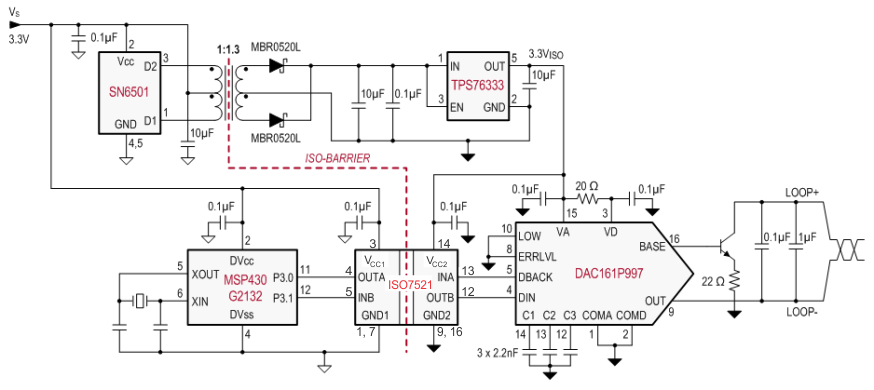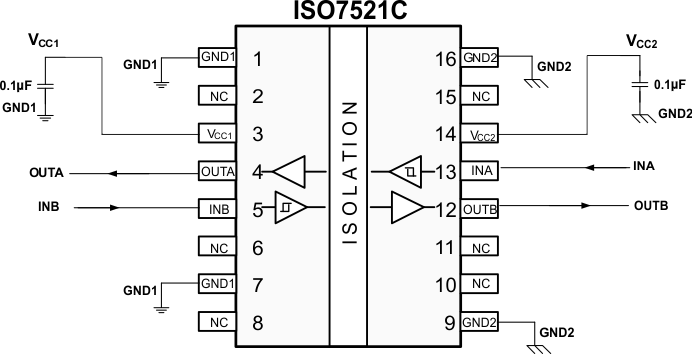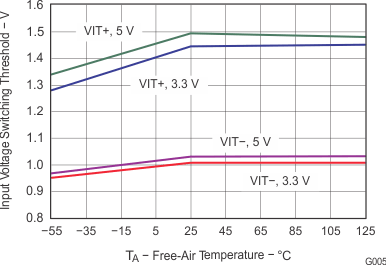SLLSE39E June 2010 – May 2015 ISO7520C , ISO7521C
PRODUCTION DATA.
- 1 Features
- 2 Applications
- 3 Description
- 4 Revision History
- 5 Pin Configuration and Functions
-
6 Specifications
- 6.1 Absolute Maximum Ratings
- 6.2 ESD Ratings
- 6.3 Recommended Operating Conditions
- 6.4 Thermal Information
- 6.5 Electrical Characteristics: VCC1 and VCC2 at 5 V ± 5%
- 6.6 Electrical Characteristics: VCC1 at 5 V ± 5%, VCC2 at 3.3 V ± 5%
- 6.7 Electrical Characteristics: VCC1 at 3.3 V ± 5%, VCC2 at 5 V ± 5%
- 6.8 Electrical Characteristics: VCC1 and VCC2 at 3.3 V ± 5%
- 6.9 Switching Characteristics: VCC1 and VCC2 at 5 V ± 5%
- 6.10 Switching Characteristics: VCC1 at 5 V ± 5%, VCC2 at 3.3 V ± 5%
- 6.11 Switching Characteristics: VCC1 at 3.3 V ± 5%, VCC2 at 5 V ± 5%
- 6.12 Switching Characteristics: VCC1 and VCC2 at 3.3 V ± 5%
- 6.13 Typical Characteristics
- 7 Parameter Measurement Information
- 8 Detailed Description
- 9 Application and Implementation
- 10Power Supply Recommendations
- 11Layout
- 12Device and Documentation Support
- 13Mechanical, Packaging, and Orderable Information
Package Options
Mechanical Data (Package|Pins)
- DW|16
Thermal pad, mechanical data (Package|Pins)
- DW|16
Orderable Information
9 Application and Implementation
NOTE
Information in the following applications sections is not part of the TI component specification, and TI does not warrant its accuracy or completeness. TI’s customers are responsible for determining suitability of components for their purposes. Customers should validate and test their design implementation to confirm system functionality.
9.1 Application Information
The ISO7520C and ISO7521C are high-performance, dual-channel digital isolators with a 5-kVRMS isolation voltage. The isolator uses single-ended TTL-logic switching technology. The supply voltage range is from 3.15 V to 5.25 V for both supplies, VCC1 and VCC2. When designing with digital isolators, it is important to keep in mind that due to the single-ended design structure, digital isolators do not conform to any specific interface standard and are only intended for isolating single-ended TTL digital signal lines. The isolator is typically placed between the data controller (that is, μC or UART), and a data converter or a line transceiver, regardless of the interface type or standard.
9.2 Typical Application
The ISO7521C can be used with Texas Instruments' mixed signal micro-controller, digital-to-analog converter, transformer driver, and voltage regulator to create an isolated 4- to 20-mA current loop.
 Figure 10. Isolated 4-20 mA Current Loop
Figure 10. Isolated 4-20 mA Current Loop
9.2.1 Design Requirements
For the ISO7521C, use the parameters shown in Table 2.
Table 2. ISO752xC Design Parameters
| PARAMETER | VALUE |
|---|---|
| Supply voltage | 3.15 V to 5.25 V |
| Decoupling capacitor between VCC1 and GND1 | 0.1 µF |
| Decoupling capacitor from VCC2 and GND2 | 0.1 µF |
9.2.2 Detailed Design Procedure
Unlike optocouplers, which need external components to improve performance, provide bias, or limit current, the ISO7521C only needs two external bypass capacitors to operate.
 Figure 11. Typical ISO7521C Circuit Hook-up
Figure 11. Typical ISO7521C Circuit Hook-up
9.2.3 Application Curve
 Figure 12. Input Voltage Switching Threshold vs Free-Air Temperature
Figure 12. Input Voltage Switching Threshold vs Free-Air Temperature